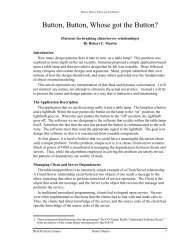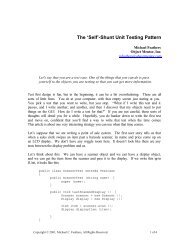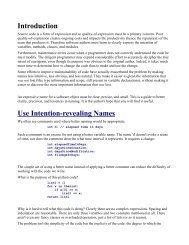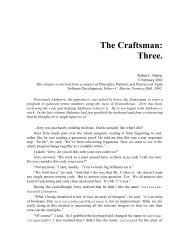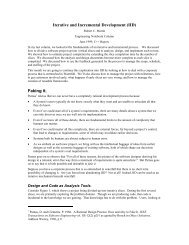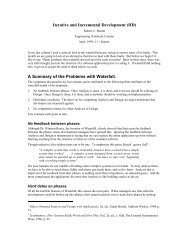The Craftsman #2 - Object Mentor
The Craftsman #2 - Object Mentor
The Craftsman #2 - Object Mentor
- No tags were found...
You also want an ePaper? Increase the reach of your titles
YUMPU automatically turns print PDFs into web optimized ePapers that Google loves.
<strong>The</strong> <strong>Craftsman</strong>:Two.Robert C. Martin13 February 2002This chapter is derived from a chapter of Principles, Patterns, and Practices of AgileSoftware Development, Robert C. Martin, Prentice Hall, 2002.Dear Diary,13 February 2002,Today was a disaster – I really messed it up. I wanted so much to impress thejourneymen here, but all I did was make a mess.It was my first day on the job as an apprentice to Mr. C. I was lucky to get thisapprenticeship. Mr. C is a well recognized master of software development. <strong>The</strong>competition for this position was fierce. Mr. C’s apprentices often become journeymenin high demand. It means something to have worked with Mr. C. ...In last month’s column Alphonse, the apprentice, was asked by Jerry, theJouneyman, to write a program to generate prime numbers using the sieve ofEratosthenes. Jerry, noting that Alponse implemented the entire algorithm in a singlegargantuan function has asked Alphonse to split it by separating the three concepts:inialization, generation, and output preparation;... but Alphonse doesn’t know how tostart...He looked at me for awhile, clearly expecting me to do something. But finally heheaved a sigh, shook his head, and continued. “To expose these three concepts moreclearly, I want you to extract them into three separate methods. Also get rid of all theunnecessary comments and pick a better name for the class. When you are done withthat, make sure all the tests still run.”You can see what I did in Listing 3. I’ve marked my changes in bold, just likeMartin Fowler does in his Refactoring book. I changed the name of the class to a noun,got rid of all the comments about Eratosthenes, and made three methods out of the threeconcepts in the generatePrimes function.
Extracting the three functions forced me to promote some of the variables of thefunction to static fields of the class. Jerry said that this made it much clearer whichvariables are local and which have wider influence.Listing 3PrimeGenerator.java, version 2/*** This class Generates prime numbers up to a user specified* maximum. <strong>The</strong> algorithm used is the Sieve of Eratosthenes.* Given an array of integers starting at 2:* Find the first uncrossed integer, and cross out all its* multiples. Repeat until the first uncrossed integer exceeds* the square root of the maximum value.*/import java.util.*;public class PrimeGenerator{private static int s;private static boolean[] f;private static int[] primes;public static int[] generatePrimes(int maxValue){if (maxValue < 2)return new int[0];else{initializeSieve(maxValue);sieve();loadPrimes();return primes; // return the primes}}private static void loadPrimes(){int i;int j;// how many primes are there?int count = 0;for (i = 0; i < s; i++){if (f[i])count++; // bump count.}primes = new int[count];// move the primes into the result
for (i = 0, j = 0; i < s; i++){if (f[i]) // if primeprimes[j++] = i;}}private static void sieve(){int i;int j;for (i = 2; i < Math.sqrt(s) + 1; i++){if (f[i]) // if i is uncrossed, cross out its multiples.{for (j = 2 * i; j < s; j += i)f[j] = false; // multiple is not prime}}}private static void initializeSieve(int maxValue){// declarationss = maxValue + 1; // size of arrayf = new boolean[s];int i;// initialize array to true.for (i = 0; i < s; i++)f[i] = true;}}// get rid of known non-primesf[0] = f[1] = false;Jerry told me that this was a little messy, so he took the keyboard and showed mehow to clean it up. Listing 4 shows what he did. First he got rid of the s variable ininitializeSieve and replacing it with f.length. <strong>The</strong>n he changed the names ofthe three functions to something he said was a bit more expressive. Finally he rearrangedthe innards of initializeArrayOfIntegers (née initializeSieve) to be a littlenicer to read. <strong>The</strong> tests all still ran.Listing 4PrimeGenerator.java, version 3 (partial)public class PrimeGenerator{private static boolean[] f;private static int[] result;
public static int[] generatePrimes(int maxValue){if (maxValue < 2)return new int[0];else{initializeArrayOfIntegers(maxValue);}}crossOutMultiples();putUncrossedIntegersIntoResult();return result;private static void initializeArrayOfIntegers(int maxValue){f = new boolean[maxValue + 1];f[0] = f[1] = false; //neither primes nor multiples.for (int i = 2; i < f.length; i++)f[i] = true;}I had to admit, this was a bit cleaner. I’d always thought it was a waste of time togive functions long descriptive names, but his changes really did make the code morereadable.Next Jerry pointed at crossOutMultiples. He said he thought the if(f[i] ==true) statements could be made more readable. I thought about it for a minute. <strong>The</strong>intent of those statements was to check to see if i was uncrossed; so I changed the nameof f to unCrossed.Jerry said that this was better, but still wasn’t pleased with it because it lead todouble negatives like unCrossed[i] = false. So he changed the name of the array toisCrossed and changed the sense of all the booleans. <strong>The</strong>n he ran all the tests.Jerry got rid of the initialization that set isCrossed[0] and isCrossed[1] totrue. He said it was good enough to just made sure that no part of the function used theisCrossed array for indexes less than 2. <strong>The</strong> tests all still ran.Jerry extracted the inner loop of the crossOutMultiples function and called itcrossOutMultiplesOf. He said that statements like if (isCrossed[i] ==false) were confusing so he created a function called notCrossed and changed the ifstatement to if (notCrossed(i)). <strong>The</strong>n he ran the tests.<strong>The</strong>n Jerry asked me what that square root was all about. I spent a bit of time writinga comment that tried to explain why you only have to iterate up to the square root of thearray size. I tried to emulate Jerry by extracting the calculation into a function where Icould put the explanatory comment. In writing the comment I realized that the squareroot is the maximum prime factor of any of the integers in the array. So I chose that name
for the variables and functions that dealt with it. Finally, I made sure that the tests all stillran. <strong>The</strong> result of all these changes are shown in Listing 5.Listing 5PrimeGenerator.java version 4 (partial)public class PrimeGenerator{private static boolean[] isCrossed;private static int[] result;public static int[] generatePrimes(int maxValue){if (maxValue < 2)return new int[0];else{initializeArrayOfIntegers(maxValue);crossOutMultiples();putUncrossedIntegersIntoResult();return result;}}private static void initializeArrayOfIntegers(int maxValue){isCrossed = new boolean[maxValue + 1];}for (int i = 2; i < isCrossed.length; i++)isCrossed[i] = false;private static void crossOutMultiples(){int maxPrimeFactor = calcMaxPrimeFactor();for (int i = 2; i sqrt of the size of the array, then// q will never be greater than 1. Thus p is the// largest prime factor in the array, and is also// the iteration limit.double maxPrimeFactor = Math.sqrt(isCrossed.length) + 1;return (int) maxPrimeFactor;}private static void crossOutMultiplesOf(int i)
{}for (int multiple = 2*i;multiple < isCrossed.length;multiple += i)isCrossed[multiple] = true;private static boolean notCrossed(int i){return isCrossed[i] == false;}I was starting to get the hang of this so I took a look at the putUncrossed-IntegersIntoResult method. I saw that this method had two parts. <strong>The</strong> first countsthe number of uncrossed integers in the array, and creates the result array of that size. <strong>The</strong>second moves the uncrossed integers into the result array. So, as you can see in Listing 6,I extracted the first part into its own function and did some miscellaneous cleanup. <strong>The</strong>tests all still ran. Jerry was just barely nodding his head. Did he actually like what I did?Listing 6PrimeGenerator.java, version 5 (partial).private static void putUncrossedIntegersIntoResult(){result = new int[numberOfUncrossedIntegers()];for (int j = 0, i = 2; i < isCrossed.length; i++)if (notCrossed(i))result[j++] = i;}private static int numberOfUncrossedIntegers(){int count = 0;for (int i = 2; i < isCrossed.length; i++)if (notCrossed(i))count++;}return count;To Be Continued Next Month





